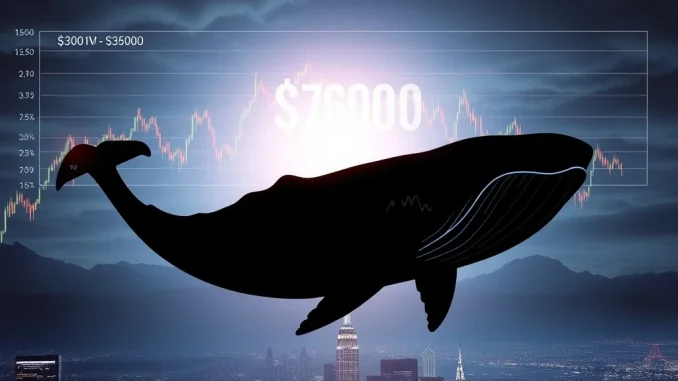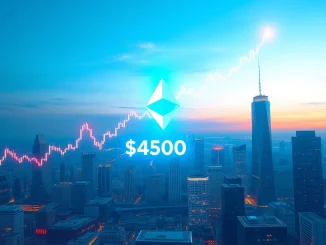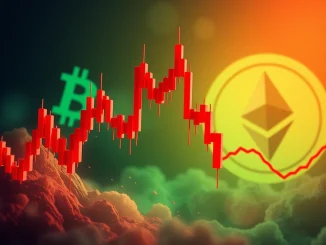
The cryptocurrency market is a dynamic landscape, often driven by the intricate dance between large institutional players and individual traders. Recently, all eyes have been on Ethereum (ETH) as it approached the critical $3,600 psychological level. This isn’t just a number; it’s a battleground where powerful market forces are clashing, creating significant volatility and opportunities. Understanding these dynamics is crucial for anyone following Ethereum news today, especially given the immense $3.5 billion in leveraged long positions hovering just below this threshold.
Understanding Leveraged Longs and Whale Strategies
What exactly are ‘leveraged longs’ and why are they so significant in the current Ethereum market? Simply put, a leveraged long position allows traders to amplify their exposure to an asset’s price movements by borrowing funds. If the price goes up, their profits are magnified. However, if the price drops, even slightly, their losses are also amplified, leading to potential liquidations.
This is where the ‘whales’ come in. These are large holders or entities with substantial capital, capable of moving markets. In the current scenario, data suggests these whales are strategically targeting these overleveraged retail traders. Their goal? To trigger cascading liquidations, which can push the price down further, allowing them to buy ETH at a lower price.
- The Trap: A massive concentration of leveraged long positions near a key resistance level ($3,600) creates an attractive target.
- The Trigger: Whales can execute large sell orders or manipulate liquidity to push the price down, forcing these leveraged positions to close.
- The Cascade: As positions are liquidated, more sell orders hit the market, accelerating the downward momentum and creating a ‘liquidation cascade.’
A recent example highlights this danger: a $26 million liquidation of a 15x leveraged position held by Aguila Trades at $3,650. This event underscored the intensified bearish pressure and served as a stark warning of what could follow if the $3,600 level is breached downwards.
The $3,600 Battleground: A Critical Juncture for ETH Price
The $3,600 level has emerged as a pivotal point for ETH price action. According to market analysts and tracking platforms, this zone represents a strategic opportunity for large holders to manipulate liquidity and amplify volatility. COINOTAG sources indicate that whales are actively exploiting these retail vulnerabilities, creating a high-stakes environment for Ethereum.
LitixApp data further corroborates this imbalance, showing that most leveraged short positions have been eliminated, leaving leveraged longs disproportionately exposed. This means that the market is currently more susceptible to downward movements triggered by liquidations, as there are fewer short positions to cushion the fall or to be liquidated themselves on an upward move.
Analysts are issuing warnings: even minor price dips could trigger widespread liquidations, especially for positions with leverage ratios above 10:1, which face heightened margin call risks. This makes the $3,600 level not just a psychological barrier, but a technical one, with significant financial implications for many traders.
Institutional Confidence vs. Market Volatility: A Tale of Two Trends
Amidst this high-stakes game of liquidations, an interesting counter-narrative emerges: institutional confidence. BlackRock’s Ethereum ETF recently added a substantial $100 million in ETH holdings. This move signals a strong vote of confidence from a major institutional player, suggesting a long-term bullish outlook despite the current market fragility. It highlights a dichotomy: while short-term volatility is driven by speculative trading and whale activity, long-term fundamentals and institutional adoption continue to strengthen Ethereum’s position.
However, this institutional backing didn’t prevent Ethereum’s immediate price action from retreating. ETH dipped to $3,590.66 USDT, a 2.08% decline from its recent peak of $3,850. A brief rebound from the $3,550 support zone failed to sustain momentum, reflecting lingering bearish sentiment and underlying structural weakness in the face of high-profile liquidations. This push-and-pull between retail leverage and institutional accumulation paints a complex picture for the future of Ethereum news today.
Decoding Crypto Liquidations: What You Need to Know
The term ‘crypto liquidations‘ has been frequently mentioned, and for good reason. CoinGlass data revealed a staggering $500 million in crypto market liquidations over the prior 24 hours across various cryptocurrencies, underscoring systemic leverage risks. Liquidations occur when a trader’s leveraged position is automatically closed by an exchange because they no longer have sufficient margin to keep the trade open. This typically happens when the market moves against their position.
The sheer volume of recent liquidations highlights how precarious the market can be, especially for those using high leverage. While short-term rebounds can indicate resilience, experts like Michaël van de Poppe note that Ethereum’s current phase represents a consolidation period before a potential larger correction. This means that despite brief recoveries, the underlying market structure might still be vulnerable to further downward pressure.
Navigating Ethereum’s Future: Consolidation or Correction?
The question on everyone’s mind is: what’s next for Ethereum? A sustained recovery above $3,650 could reinvigorate bullish sentiment, potentially signaling that the worst of the liquidation cascade is over and buyers are stepping in with conviction. However, a breakdown below the crucial $3,500 support level would likely confirm a deeper bearish trend, possibly leading to further significant price drops.
The interplay between Ethereum whales activity and leveraged positions remains a key driver of volatility. Whale-driven strategies, including large block trades or even ‘wash trades’ (though less common and often illegal), can accelerate price declines by triggering forced liquidations. Market observers emphasize the importance of monitoring trading volume and price action around the $3,600 mark to anticipate the next phase of movement. As one analyst put it, “The next few hours could define Ethereum’s near-term direction, but macroeconomic factors like ETF inflows and regulatory developments will ultimately shape long-term outcomes.”
Actionable Insights for Ethereum Investors
In such a volatile environment, staying informed and adopting a cautious approach is paramount. Here are some key takeaways:
- Monitor Key Levels: Keep a close eye on the $3,600 resistance and $3,500 support levels. These will be critical indicators for short-term price direction.
- Understand Leverage: If you’re considering leveraged trading, understand the extreme risks involved. Even small price movements can lead to significant losses.
- Track Whale Activity: Utilize on-chain analytics tools to track large transactions and whale movements, as these can foreshadow significant market shifts.
- Consider Long-Term Fundamentals: While short-term price action is exciting, remember Ethereum’s strong fundamentals, its role in the decentralized ecosystem, and growing institutional interest.
- Risk Management: Always employ robust risk management strategies, including setting stop-loss orders and not over-allocating capital.
The current state of Ethereum highlights the ongoing tension between market speculation and underlying value. While the immediate future may be marked by volatility driven by whale activity and liquidation risks, Ethereum’s long-term trajectory continues to be influenced by its technological advancements and increasing institutional adoption. Navigating these turbulent waters requires vigilance, a clear understanding of market dynamics, and a disciplined approach to investing.
Frequently Asked Questions (FAQs)
Q1: What are leveraged long positions in crypto?
A1: Leveraged long positions allow traders to bet on an asset’s price increasing using borrowed funds, amplifying potential profits but also magnifying losses and increasing liquidation risk if the price moves unfavorably.
Q2: How do ‘whales’ impact the Ethereum market?
A2: Whales are large holders of Ethereum who can significantly influence market prices through large buy or sell orders. They often target overleveraged positions to trigger liquidations, which can create cascading sell-offs and drive prices down, allowing them to accumulate more at lower prices.
Q3: What does the $3,600 level mean for Ethereum?
A3: The $3,600 level is a critical psychological and technical resistance point for Ethereum. A large concentration of leveraged long positions just below this level makes it a key battleground, with potential for significant liquidations if the price drops even slightly below it.
Q4: What are crypto liquidations and why are they important?
A4: Crypto liquidations occur when an exchange automatically closes a trader’s leveraged position due to insufficient margin. They are important because large-scale liquidations can create significant downward price pressure, leading to further market volatility and potential crashes.
Q5: Is BlackRock’s Ethereum ETF a positive sign despite current volatility?
A5: Yes, BlackRock’s Ethereum ETF adding $100 million in ETH holdings is generally seen as a positive sign of growing institutional confidence and long-term adoption, even amidst short-term market volatility driven by speculative trading and whale activity.
Q6: What should Ethereum investors do during periods of high volatility?
A6: During high volatility, investors should prioritize risk management, monitor key price levels, understand the impact of leverage, track whale activity, and focus on Ethereum’s long-term fundamentals rather than short-term price swings. Diversification and careful position sizing are also crucial.



